2023 HYUNDAI IONIQ 6 steering
[x] Cancel search: steeringPage 362 of 582

Driver Assistance System
7-18
if equipped
Evasive Steering Assist function
Evasive Steering Assist function will warn
and control the vehicle with ‘Emergency
steering’.
Emergency Steering (Driver steering
assist)
B7000317
• To warn the driver that emergency steering will be assisted, Emergency
Steering warning light ( ) blinking, the
‘Emergency Steering’ message will
appear on the instrument cluster, an
audible warning will sound and the
steering wheel will vibrate.
• If there is a risk of collision with a vehicle, powered two-wheeler,
pedestrian and cyclist in front, the
steering will be assisted to help prevent
collision when the driver steers the
vehicle to avoid collision.
• The function will operate when your vehicle speed is between about 25-53
mph (40-85 km/h). Emergency Steering (Evasive steering
assist)
B7000317
• To warn the driver that emergency
steering will be assisted, Emergency
Steering warning light ( ) blinking, the
‘Emergency Steering’ message will
appear on the instrument cluster, an
audible warning will sound and the
steering wheel will vibrate.
• If there is high risk of collision with a pedestrian and cyclist in front, and the
vehicle speed to operate emergency
braking is within the operation range,
the steering will be assisted to help
prevent collision when there is space to
avoid collision in the driving lane.
• The function will operate when your vehicle speed is between about 40-47
mph (65-75 km/h).
CAUTION • The steering wheel may turn automatically when emergency
steering is operating.
• Emergency steering will automatically cancel when risk factors disappear. The
driver must steer the vehicle.
• Emergency steering may not operate or may cancel during operation if the
steering wheel is held tight or steered in
the opposite direction.
• When steering is assisted to avoid collision with a vehicle, powered
two-wheeler, pedestrian and cyclist,
Evasive steering assist will be canceled
Hyundai_CE_en_US.book Page 18
Page 363 of 582
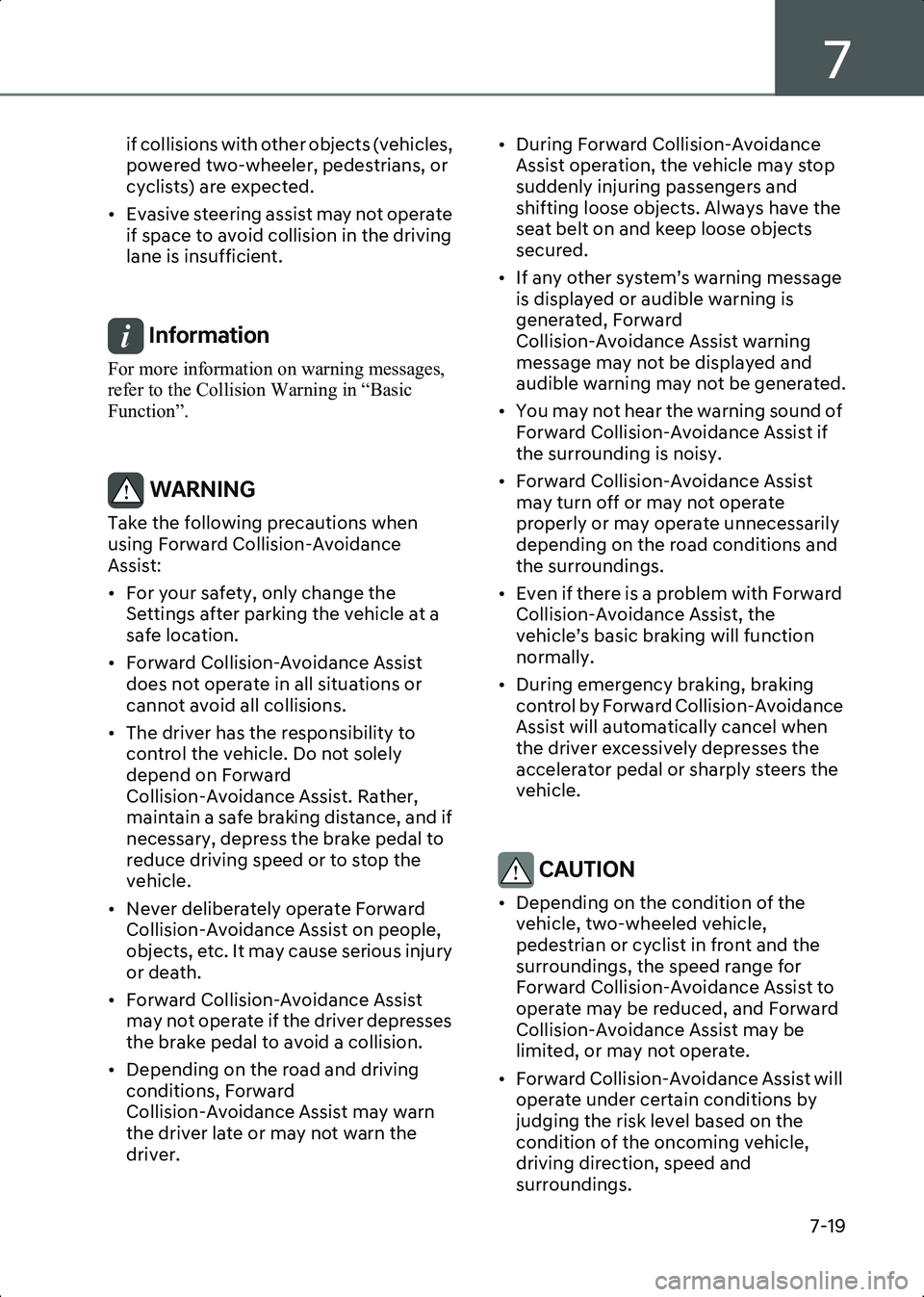
7
7-19
if collisions with other objects (vehicles,
powered two-wheeler, pedestrians, or
cyclists) are expected.
• Evasive steering assist may not operate if space to avoid collision in the driving
lane is insufficient.
Information For more information on warning messages,
refer to the Collision Warning in “Basic
Function”.
WARNING Take the following precautions when
using Forward Collision-Avoidance
Assist:
• For your safety, only change the Settings after parking the vehicle at a
safe location.
• Forward Collision-Avoidance Assist does not operate in all situations or
cannot avoid all collisions.
• The driver has the responsibility to control the vehicle. Do not solely
depend on Forward
Collision-Avoidance Assist. Rather,
maintain a safe braking distance, and if
necessary, depress the brake pedal to
reduce driving speed or to stop the
vehicle.
• Never deliberately operate Forward Collision-Avoidance Assist on people,
objects, etc. It may cause serious injury
or death.
• Forward Collision-Avoidance Assist may not operate if the driver depresses
the brake pedal to avoid a collision.
• Depending on the road and driving conditions, Forward
Collision-Avoidance Assist may warn
the driver late or may not warn the
driver. • During Forward Collision-Avoidance
Assist operation, the vehicle may stop
suddenly injuring passengers and
shifting loose objects. Always have the
seat belt on and keep loose objects
secured.
• If any other system’s warning message is displayed or audible warning is
generated, Forward
Collision-Avoidance Assist warning
message may not be displayed and
audible warning may not be generated.
• You may not hear the warning sound of Forward Collision-Avoidance Assist if
the surrounding is noisy.
• Forward Collision-Avoidance Assist may turn off or may not operate
properly or may operate unnecessarily
depending on the road conditions and
the surroundings.
• Even if there is a problem with Forward Collision-Avoidance Assist, the
vehicle’s basic braking will function
normally.
• During emergency braking, braking control by Forward Collision-Avoidance
Assist will automatically cancel when
the driver excessively depresses the
accelerator pedal or sharply steers the
vehicle.
CAUTION • Depending on the condition of the vehicle, two-wheeled vehicle,
pedestrian or cyclist in front and the
surroundings, the speed range for
Forward Collision-Avoidance Assist to
operate may be reduced, and Forward
Collision-Avoidance Assist may be
limited, or may not operate.
• Forward Collision-Avoidance Assist will operate under certain conditions by
judging the risk level based on the
condition of the oncoming vehicle,
driving direction, speed and
surroundings.
Hyundai_CE_en_US.book Page 19
Page 364 of 582
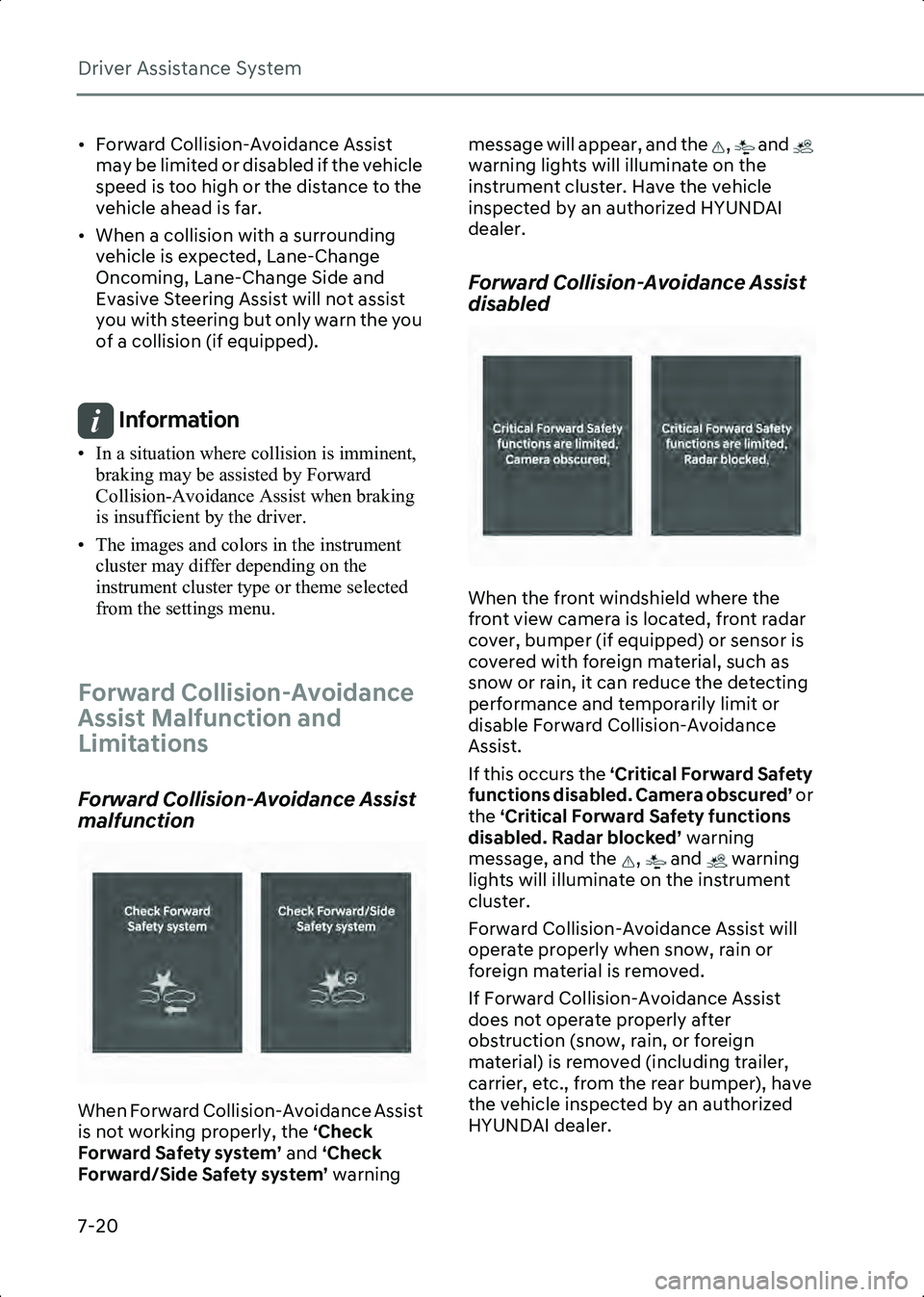
Driver Assistance System
7-20
• Forward Collision-Avoidance Assist may be limited or disabled if the vehicle
speed is too high or the distance to the
vehicle ahead is far.
• When a collision with a surrounding vehicle is expected, Lane-Change
Oncoming, Lane-Change Side and
Evasive Steering Assist will not assist
you with steering but only warn the you
of a collision (if equipped).
Information • In a situation where collision is imminent, braking may be assisted by Forward
Collision-Avoidance Assist when braking
is insufficient by the driver.
• The images and colors in the instrument cluster may differ depending on the
instrument cluster type or theme selected
from the settings menu.
Forward Collision-Avoidance
Assist Malfunction and
Limitations
Forward Collision-Avoidance Assist
malfunction
B7000401
When Forward Collision-Avoidance Assist
is not working properly, the ‘Check
Forward Safety system’ and ‘Check
Forward/Side Safety system’ warning message will appear, and the , and
warning lights will illuminate on the
instrument cluster. Have the vehicle
inspected by an authorized HYUNDAI
dealer.
Forward Collision-Avoidance Assist
disabled
B7000402
When the front windshield where the
front view camera is located, front radar
cover, bumper (if equipped) or sensor is
covered with foreign material, such as
snow or rain, it can reduce the detecting
performance and temporarily limit or
disable Forward Collision-Avoidance
Assist.
If this occurs the ‘Critical Forward Safety
functions disabled. Camera obscured’ or
the ‘Critical Forward Safety functions
disabled. Radar blocked’ warning
message, and the , and warning
lights will illuminate on the instrument
cluster.
Forward Collision-Avoidance Assist will
operate properly when snow, rain or
foreign material is removed.
If Forward Collision-Avoidance Assist
does not operate properly after
obstruction (snow, rain, or foreign
material) is removed (including trailer,
carrier, etc., from the rear bumper), have
the vehicle inspected by an authorized
HYUNDAI dealer.
Hyundai_CE_en_US.book Page 20
Page 367 of 582
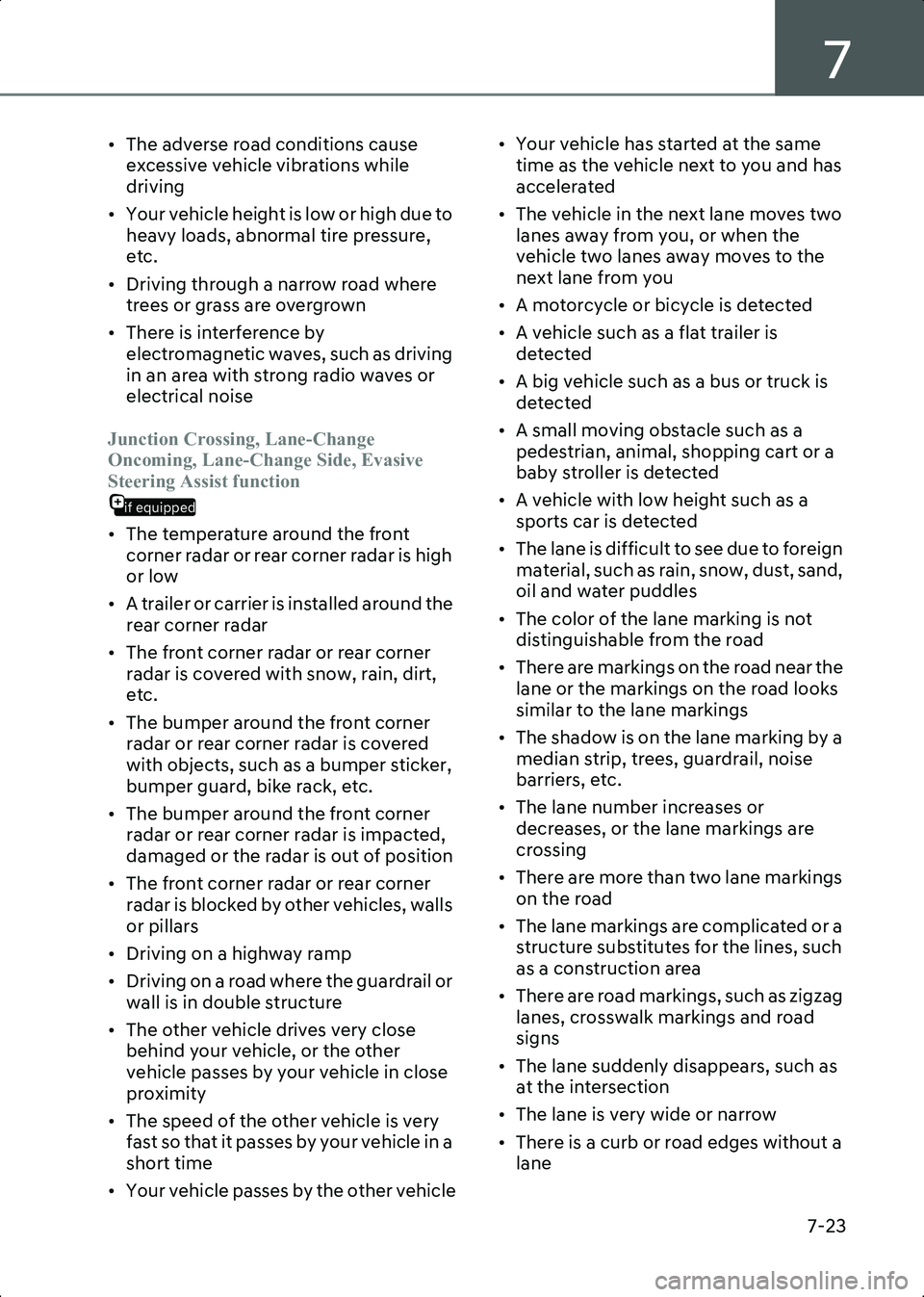
7
7-23
• The adverse road conditions cause excessive vehicle vibrations while
driving
• Your vehicle height is low or high due to heavy loads, abnormal tire pressure,
etc.
• Driving through a narrow road where trees or grass are overgrown
• There is interference by electromagnetic waves, such as driving
in an area with strong radio waves or
electrical noise
Junction Crossing, Lane-Change
Oncoming, Lane-Change Side, Evasive
if equipped
Steering Assist function
• The temperature around the front corner radar or rear corner radar is high
or low
• A trailer or carrier is installed around the rear corner radar
• The front corner radar or rear corner radar is covered with snow, rain, dirt,
etc.
• The bumper around the front corner radar or rear corner radar is covered
with objects, such as a bumper sticker,
bumper guard, bike rack, etc.
• The bumper around the front corner radar or rear corner radar is impacted,
damaged or the radar is out of position
• The front corner radar or rear corner radar is blocked by other vehicles, walls
or pillars
• Driving on a highway ramp
• Driving on a road where the guardrail or wall is in double structure
• The other vehicle drives very close behind your vehicle, or the other
vehicle passes by your vehicle in close
proximity
• The speed of the other vehicle is very fast so that it passes by your vehicle in a
short time
• Your vehicle passes by the other vehicle • Your vehicle has started at the same
time as the vehicle next to you and has
accelerated
• The vehicle in the next lane moves two lanes away from you, or when the
vehicle two lanes away moves to the
next lane from you
• A motorcycle or bicycle is detected
• A vehicle such as a flat trailer is detected
• A big vehicle such as a bus or truck is detected
• A small moving obstacle such as a pedestrian, animal, shopping cart or a
baby stroller is detected
• A vehicle with low height such as a sports car is detected
• The lane is difficult to see due to foreign material, such as rain, snow, dust, sand,
oil and water puddles
• The color of the lane marking is not distinguishable from the road
• There are markings on the road near the lane or the markings on the road looks
similar to the lane markings
• The shadow is on the lane marking by a median strip, trees, guardrail, noise
barriers, etc.
• The lane number increases or decreases, or the lane markings are
crossing
• There are more than two lane markings on the road
• The lane markings are complicated or a structure substitutes for the lines, such
as a construction area
• There are road markings, such as zigzag lanes, crosswalk markings and road
signs
• The lane suddenly disappears, such as at the intersection
• The lane is very wide or narrow
• There is a curb or road edges without a lane
Hyundai_CE_en_US.book Page 23
Page 368 of 582
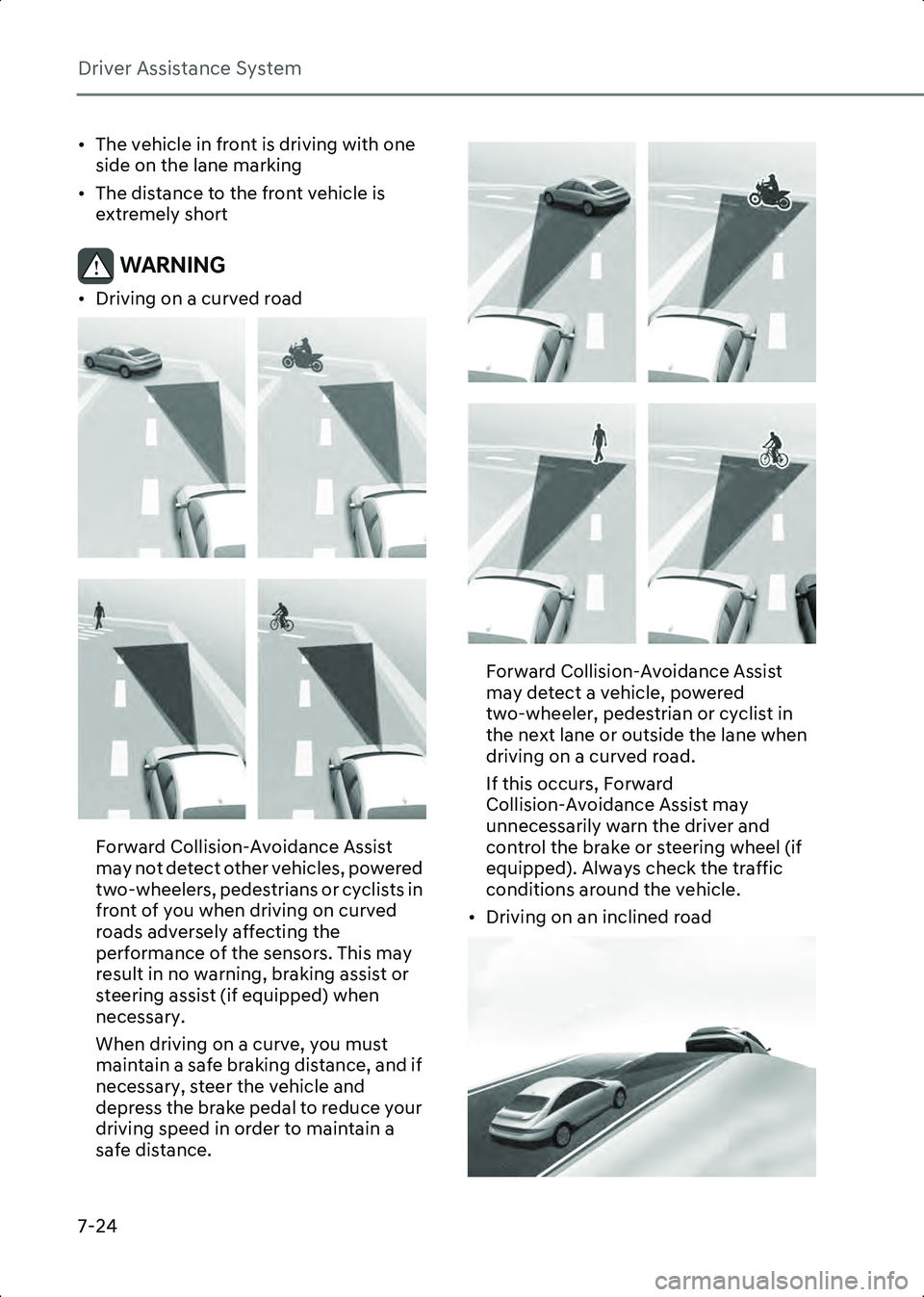
Driver Assistance System
7-24
• The vehicle in front is driving with one side on the lane marking
• The distance to the front vehicle is extremely short
WARNING • Driving on a curved road
B7000404
B7000405
Forward Collision-Avoidance Assist
may not detect other vehicles, powered
two-wheelers, pedestrians or cyclists in
front of you when driving on curved
roads adversely affecting the
performance of the sensors. This may
result in no warning, braking assist or
steering assist (if equipped) when
necessary.
When driving on a curve, you must
maintain a safe braking distance, and if
necessary, steer the vehicle and
depress the brake pedal to reduce your
driving speed in order to maintain a
safe distance.
B7000406
B7000407
Forward Collision-Avoidance Assist
may detect a vehicle, powered
two-wheeler, pedestrian or cyclist in
the next lane or outside the lane when
driving on a curved road.
If this occurs, Forward
Collision-Avoidance Assist may
unnecessarily warn the driver and
control the brake or steering wheel (if
equipped). Always check the traffic
conditions around the vehicle.
• Driving on an inclined road
B7000408
Hyundai_CE_en_US.book Page 24
Page 369 of 582
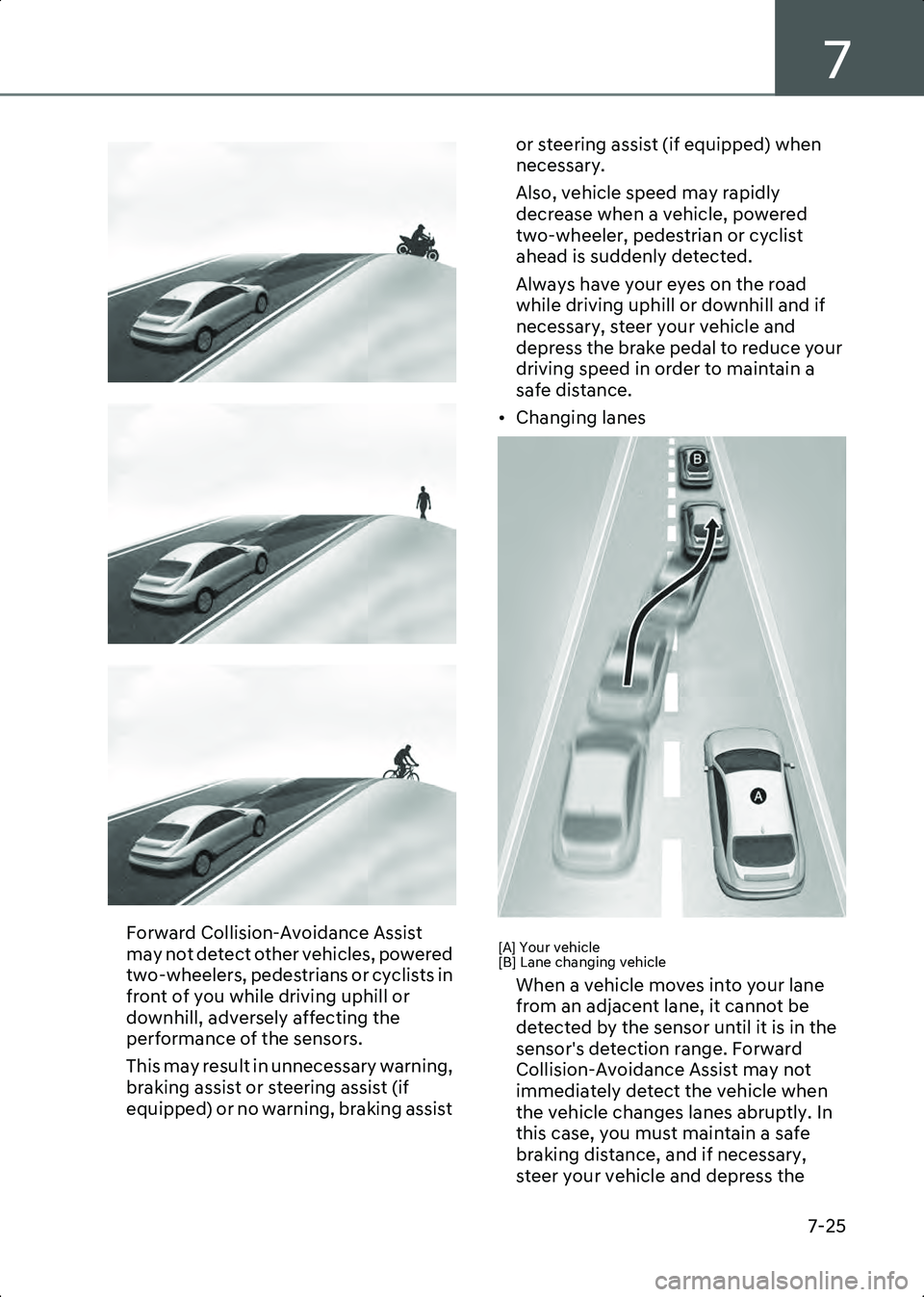
7
7-25
B7000409
B7000410
B7000411
Forward Collision-Avoidance Assist
may not detect other vehicles, powered
two-wheelers, pedestrians or cyclists in
front of you while driving uphill or
downhill, adversely affecting the
performance of the sensors.
This may result in unnecessary warning,
braking assist or steering assist (if
equipped) or no warning, braking assist or steering assist (if equipped) when
necessary.
Also, vehicle speed may rapidly
decrease when a vehicle, powered
two-wheeler, pedestrian or cyclist
ahead is suddenly detected.
Always have your eyes on the road
while driving uphill or downhill and if
necessary, steer your vehicle and
depress the brake pedal to reduce your
driving speed in order to maintain a
safe distance.
• Changing lanesB7000412
[A] Your vehicle
[B] Lane changing vehicle
When a vehicle moves into your lane
from an adjacent lane, it cannot be
detected by the sensor until it is in the
sensor's detection range. Forward
Collision-Avoidance Assist may not
immediately detect the vehicle when
the vehicle changes lanes abruptly. In
this case, you must maintain a safe
braking distance, and if necessary,
steer your vehicle and depress the
Hyundai_CE_en_US.book Page 25
Page 371 of 582
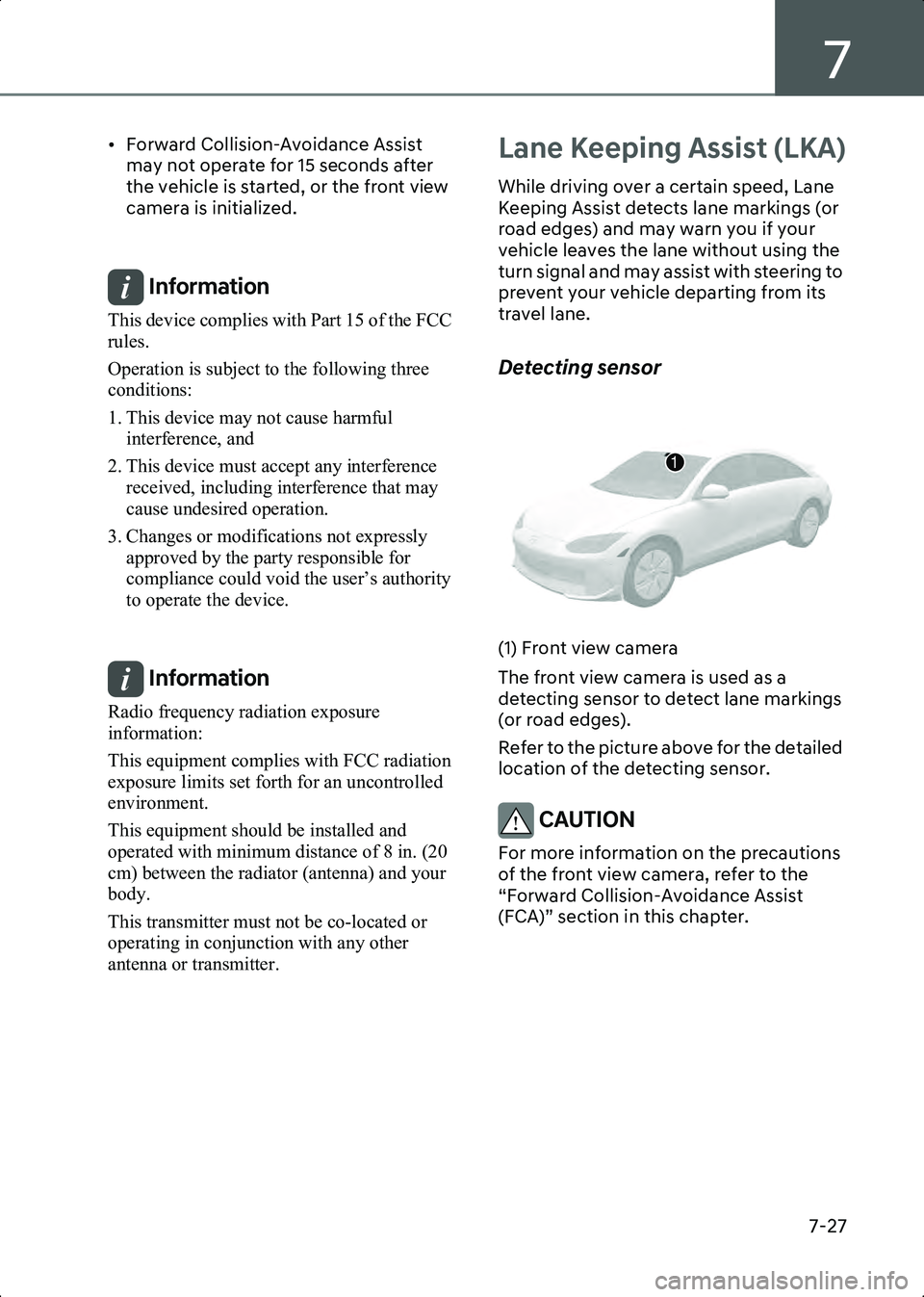
7
7-27
• Forward Collision-Avoidance Assist may not operate for 15 seconds after
the vehicle is started, or the front view
camera is initialized.
Information This device complies with Part 15 of the FCC
rules.
Operation is subject to the following three
conditions:
1. This device may not cause harmful interference, and
2. This device must accept any interference received, including interference that may
cause undesired operation.
3. Changes or modifications not expressly approved by the party responsible for
compliance could void the user’s authority
to operate the device.
Information Radio frequency radiation exposure
information:
This equipment complies with FCC radiation
exposure limits set forth for an uncontrolled
environment.
This equipment should be installed and
operated with minimum distance of 8 in. (20
cm) between the radiator (antenna) and your
body.
This transmitter must not be co-located or
operating in conjunction with any other
antenna or transmitter.
Lane Keeping Assist (LKA)
While driving over a certain speed, Lane
Keeping Assist detects lane markings (or
road edges) and may warn you if your
vehicle leaves the lane without using the
turn signal and may assist with steering to
prevent your vehicle departing from its
travel lane.
Detecting sensor
B7000901(1) Front view camera
The front view camera is used as a
detecting sensor to detect lane markings
(or road edges).
Refer to the picture above for the detailed
location of the detecting sensor.
CAUTION For more information on the precautions
of the front view camera, refer to the
“Forward Collision-Avoidance Assist
(FCA)” section in this chapter.
1
Hyundai_CE_en_US.book Page 27
Page 372 of 582

Driver Assistance System
7-28
Lane Keeping Assist Settings
Lane Safety
B7001001
With the vehicle on, select Setup >
Vehicle > Driver Assistance > Driving
Safety > Lane Safety from the Settings
menu to set whether to use each
function.
If Lane Safety is selected, Lane Keeping
Assist will automatically assist the driver’s
steering when lane departure is detected
to help prevent the vehicle from moving
out of its lane. If Lane Safety is
deselected, Lane keeping Assist will turn
off and the ( ) indicator light will turn off
on the instrument cluster.
WARNING • Lane Keeping Assist does not control the steering wheel when the vehicle is
driven in the middle of the lane.
• The driver should always be aware of the surroundings. If Lane Safety is
deselected, Lane Keeping Assist cannot
assist you.
Warning Methods
B7000205_2
B7000205_3
With the vehicle on, go to Setup > Vehicle
> Driver Assistance > Warning Methods
from the Settings in the infotainment
system to select the following:
• Warning Volume : The Warning Volume
can be adjusted.
• Haptic Warning : The steering wheel
vibration can be set.
• Lane Safety Audible Warning Off : The
warning volume of Lane Safety does
not sound when Haptic Warning is
selected.
• Driving Safety Priority : Your vehicle
lowers all other audio volumes when
the Driver Assistance system warning
sounds.
Information • If you change the Warning Methods, Warning Methods of other Driver
Assistance systems may change.
Hyundai_CE_en_US.book Page 28